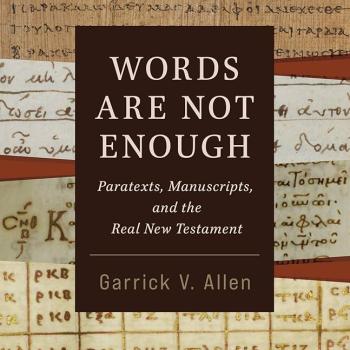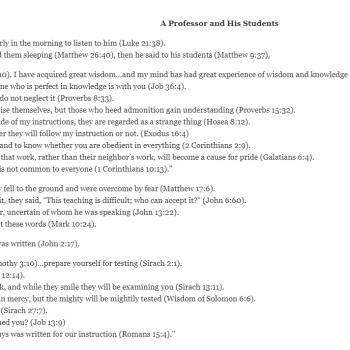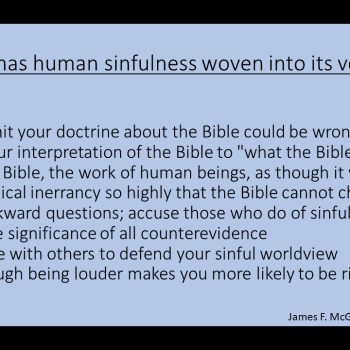The session I attended on Saturday morning was part of the Digital Humanities program unit, and was a panel focused on the book Liquid Scripture by Jeffrey Siker. What does it mean to go back to scrolling through Bibles? What happens when the Bible is read in primarily or exclusively on a screen?
Claire Clivaz spoke first, pointing out that, while an index to Thomas Aquinas is considered the first DH project, a biblical index that was created using computer around the same time is not remembered. The book covers topics such as the abundance of public domain but badly outdated works online. Clivaz also noted the disconnect between Siker’s references to the Bible as “the book of all books” and the decline of such views in her European context. It was at the end of the 19th century that the phrase “religion of the book” was first used. I confess I had not realized that the term was so recent, a product of the heyday of the print era. Can the Bible retain this status even in the United States if it ceases to be leather bound and gilded? Perhaps the most significant impact of the removal of the covers, which have in recent times to enclose and delineate the boundaries of the canon. Paradoxically, digital culture has the potential to return our focus to individual manuscripts, and is also witnessing a proliferation of audio Bibles and a resurgance of oral encounters with the texts.
Michael Hemenway began with a quote from Timothy Beal, to the effect that it’s “the end of the Word as we know it, and I feel fine.” He then moved to focus on interface, thinking about users and platforms not only today but in antiquity. We tend to think of texts as moving words from that container into another one, our brains. Siker’s book already signals that Bible reading has always been interruptive and more complex than that. On the other hand, the “digital is material.” The encoding exists in physical hardware, and we read it through physical devices. Hemenway says that the “virtual” represents a failure of translation: i.e. we find digital Bibles frustrating because we have not adapted them in appropriate ways to the new platform. He also notes that it is not only covers but even pages that are disappearing. But transitions and new possibilities of use are not new. Hemenway also focused on the use of “liquid” in the title, which can indicate dilution and destabilization, which are potentially negative, but can also conjure the more positive idea of touching the surface of the deep, as well as the ripples created when we do so. I found his Prezi, which flowed past the dimensions of the screen, to add to these provocations in ways that Hemenway clearly did not intend. He concluded with XML of biblical text, and asked whether and to what extent we as scholars know how to read or write that.
Paul Dilley read Peter Phillips’ paper since he was unable to make it. The paper began by highlighting the neglected role of women in producing the Digital Humanities in Bible-related projects. He then moved on to the fact that biblical manuscripts and printed books have rarely been the primary way that most people interacted with scripture. It was rather through mass and passion plays and other performances. And people who could not read the texts used them as amulets to ward off evil. The paper also highlighted the fact that technology has trained us to engage in “F-gaze” rather than “linear-gaze” reading. More work is needed on the neurology of digital reading. Towards the end, the paper focused on the fact that so far, we have yet to see the proliferation of different digital canons that some have predicted.
Caroline Schroeder said that the book is one that we have long needed and been waiting for. Schroeder noted the predominance of white Protestant Evangelical perspectives among the major websites and apps. But other groups have also been active, a case in point being the St. Shenouda Society’s Coptic Bible. The liquidity of Scripture is illustrated by the way the text has changed each time it has migrated to a new site. Schroeder also highlighted similar Syriac Bible projects, and then turned to others. Amy Earhart’s Traces of the Old, Uses of the New has explored how minority and marginalized voices tend to not be heard and to go defunct online. Schroeder talked about Robert Kraft’s pioneering DH work related to biblical studies, which sought to get away from the divides created by canon. Yet it is often so simple to use a category like “New Testament. And even the NASSCAL e-clavis project risks reinforcing the divide between canonical and non-canonical. Schroeder also highligted how copyright led her Coptic project to use the free eSword English translation, which is problematic, rather than something better. Schroeder warned against histories that presume a one-way influence of technology on culture, and neglecting the forces that shape the technology. The experience of people today feels like techno-determinism, perhaps forgetting the capitalist and libertarian outlook of those who create and control popular social media platforms. Zeynep Tufecki’s work was mentioned, as was a Bible Tech Confidence at which, if an online photo is anything to go by, the overwhelming majority of attendees were white men. Echo chambers are a result of advertising that feeds you things like what you have already seen in order to get you to stay on a site or click through to another. Biblical memes also illustrate the tendency of Bible verses to circulate extracted from context.
Jeffrey Siker, author of Liquid Scripture, started his response with the video of a Medieval help desk. From there, he moved to his students’ ineptitude in navigating around, not realizing quite how long some books in the Bible are and that scrolling from Genesis to Matthew would take a very long time. Siker is surprised that his book is the first of its kind, just as he was surprised by the fact that people at Logos and other Bible software companies, when asked, seemed not to have thought about how reading the Bible on a screen changes the experience. He engaged the panelists in conversation about a range of points they made. He called the Bible is a “zone of encounter” between ancient authors and modern readers, and noted the similarity between hyperlinking and something like the print Scofield chain reference Bible. There is a need for more study of readers who are not white and/or Evangelical. Siker wondered whether general studies of digital reading tell us much about digital Bible reading, since those who read the Bible tend to approach it differently.
During the open discussion, the Talmud was brought into the picture, since it represents precurs to both hyperlinking and distracted reading. Perhaps we should not be surprised that Jewish online reading of Bible and Rabbinic literature is way ahead of what we see in Christian communities. Siker used the phrase the “twittering” of the Bible, which I liked. Robert Kraft required that his students learn to code, and there was interesting discussion of whether that would ideally still be the case today. Schroeder emphasized the need to at least understand APIs. Siker asked about the extreme individualization of print editions of the NIV and how it relates to this – also mentioning that the NRSV represents only 2% of the market. Digitization may help mediate access to academic perspectives or extracanonical works, but readers will not find them unless they search for them. Audience members asked whether it would be better for students to learn computer languages than Greek or German (I would answer with an emphatic NO!), and also said that at some seminaries students learn how to use Logos Bible software rather than learning Greek.
This was a fantastic session! The question is such an important one, as to whether our digital reading context makes for an experience closer to that of our ancient forebears than that of readers during the codex era. So too is the question of what the future holds for the digitally-mediated and digitally-enhanced study of and interaction with the Bible.














